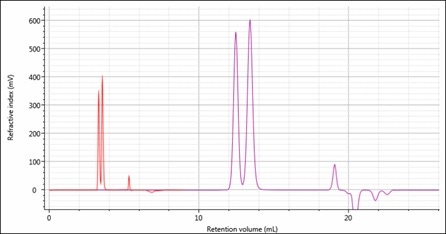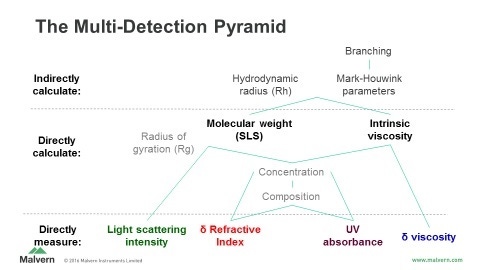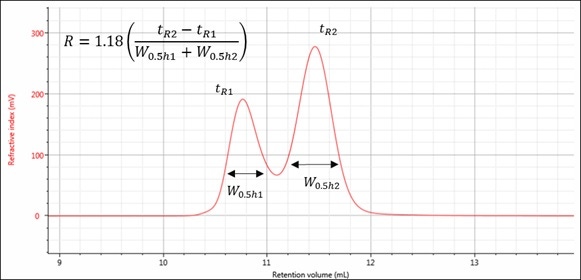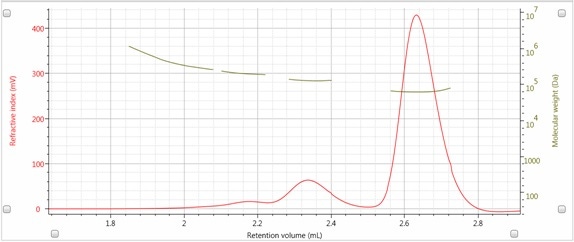OMNISEC REVEAL,
the latest GPC/SEC multi-detector module from Malvern Instruments,
was optimized for and used with a Waters APC system to provide multi-detector GPC data under UPLC conditionsUltra Performance Liquid Chromatography® (UPLC) and Advanced Polymer Chromatography™ (APC) are separations techniques that promote the use of micro-bore columns with reduced particle sizes for superior resolution and consistent data, at flow rates of up to 1 mL/min. In this application note, we describe how Malvern’s latest GPC/SEC multi-detector module, OMNISEC REVEAL, was optimized for and used with a Waters APC system to provide multi-detector data under UPLC conditions. The principle advantage of UPLC/APC is improved resolution with faster analysis time. The smaller size columns also require lower sample loading and use less carrier solvent. Figure 1 shows a comparison of measurements made with two APC columns in series vs. two analytical GPC columns in series that are optimized for the resolution of a PS30K/PS65K polystyrene pair. The UPLC measurement offers equivalent or better resolution along with a 5-fold saving in time and solvent consumption with the APC columns.

Figure 1: A sample containing PS30K and PS65K is separated on two APC columns (red) and two analytical GPC columns (purple) in series
Despite the excellent resolution and repeatability, UPLC/APC systems typically operate in a Conventional Calibration mode. With the addition of a multi detector system such as OMNISEC REVEAL, one can perform measurements of absolute molecular weight, molecular size, structure and copolymer composition. The technique of multi-detection is based on the implementation of a light scattering detector along with a viscometer for the direct measurement of absolute molecular weight and intrinsic viscosity. Figure 2 summarizes how the detectors work together to generate different molecular parameters.

Figure 2: ‘The Multi-Detection Pyramid’ showing how the detector responses from a multi-detection GPC system are combined to measure the molecular properties of the sample under analysis.
In multi-detection GPC systems, several detectors are connected in series. A sample peak will disperse or broaden slightly as it passes through each and every detector cell, and the magnitude of this band broadening behavior depends on cell volume, cell geometry and flow dynamics. Other contributions may come from unions and filters. This effect becomes more significant in UPLC systems where the peaks are especially narrow and thus presents a significant barrier to multi-detector UPLC. All these factors must be minimized in order that together they do not represent a significant dead volume and that the peak shapes are preserved throughout the detector chain in order to generate accurate results.
The standard refractive index detector in OMNISEC REVEAL was optimized for operation with UPLC, and aseries of measurements was performed to assess improvements in band broadening. In these tests a two column set was used with columns measuring 4.6 mm ID X 150 mm Length. The two columns had pore sizes of 450 and 125 Angstrom.
The calculation shown in Figure 3 was used to calculate peak resolution and compare the performance of the standard RI detector and the one that had been optimized for UPLC. The results are shown in table 1.

Figure 3: Resolution calculation used in tests comparing the standard and optimized versions of OMNISEC REVEAL.
| Polystyrene Pairs | APC | Unmodified OMNISEC REVEAL | Optimized OMNISEC REVEAL RI detector |
|---|---|---|---|
| PS2500/PS6000 | 0.89 | 0.77 | N/D |
| PS30K/PS65K | 2.07 | 1.12 | 1.64 |
| PS170K/PS400K | 2.80 | 1.16 | 1.96 |
From the results, it is clear that the modified OMNISEC REVEAL module offers significant improvements in resolution by reducing band broadening when compared with the unmodified unit and the APC. In this way, the band broadening between the detectors can be reduced so that resolution is maintained and multi-detector GPC measurements are possible on UPLC separations.
A strong test for multi-detector measurements is the analysis of a protein sample such as bovine serum albumin (BSA). Proteins elute as very monodisperse peaks which are very narrow and a single sample often contains multiple populations of oligomers. BSA is a commonly used standard protein that was used to test the final performance of multi-detector measurements. BSA was separated using the APC with optimized OMNISEC REVEAL detector using a single Waters Protein BEH 200 column (4.6 mm ID x 150mm). As can be seen in Figure 4, excellent resolution was achieved between the monomer, dimer, trimer, and larger aggregates. The molecular weight measured across the peaks has been overlaid. The flat molecular weight trace across the monomer, dimer and trimer peaks clearly displays their monodisperse nature while the larger aggregates are more polydisperse and demonstrate this in the trend in molecular weight across the peak from 1.8 to 2.1 mL. The calculated numerical results for the peaks are shown in table 2.

Figure 4: RI chromatogram (red) and overlaid molecular weight (olive green) using APC and OMNISEC REVEAL with an optimized RI detector.
| Aggregates | Trimer | Dimer | Monomer | |
|---|---|---|---|---|
| Mw | 370,800 | 206,000 | 132,900 | 66,770 |
| Mw/Mn | 1.11 | 1.00 | 1.00 | 1.01 |
GPC/SEC experiments run under UPLC/APC conditions resulted in greatly reduced analysis time and solvent consumption, compared to “standard” analytical GPC/SEC. However, the use of UPLC/APC conditions increases susceptibility to loss of resolution due to band broadening issues. By optimizing the design of OMNISEC REVEAL, we have shown that it is possible to add an OMNISEC REVEAL multi-detection module to an existing UPLC/APC-type system such as the Waters APC, to provide additional information about your sample (such as absolute molecular weight, molecular size and molecular structure) that is not available from conventional calibration approaches.